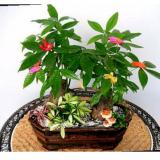
上传成功
举报
转发
2017年12月09日

桂花的修剪不仅能保持桂花的树形,更能通过疏枝改善光照和通风条件,增大花量,让植株更健康,那么盆栽桂花什么时候修剪呢?不忙,我们看下文。
[图片]
春天是最适合修剪的季节。因为桂花是常绿树,不太耐寒,所以不能在冬天修剪。
而到了夏天的7、8月份,花芽开始萌发,如果这个时候修剪势必会剪掉带花芽的树枝,导致花量减少。
地栽的桂花可以在秋天花后进行小幅度的修整,但盆栽桂花不像地栽的那么健壮,也不适合在秋天修剪。所以,盆栽的桂花最好在春天修剪,最合适的月份是3月份。
另外,太小的植株也不适合修剪,一般可以在买回来2到3年之后再开始管理株型。修剪周期是一年一次。
#盆栽桂花的修剪建议:
1.剪掉交缠在一起的枝条,一般会有好几根枝条交缠在一起,留下其中一根,其余的都要剪掉。
2.桂花的一些分支喜欢向上生长,所以要对这些向上长的枝条进行修剪疏枝。修剪前先确定好剪掉哪些,留下哪些。
3.对内膛进行疏枝,留下向外生长的侧枝,剪掉里面向内生长的枝条。
4.最后要修饰一下整体形状。把一些特别长特别突出的枝条剪短,让整体线条更加柔和。注意要在靠近叶片的地方剪断,如果剩下的树枝太长的话,会导致腋芽无法长出,进而导致整个枝条枯萎。
...显示更多
文章
滚动加载更多...
article






